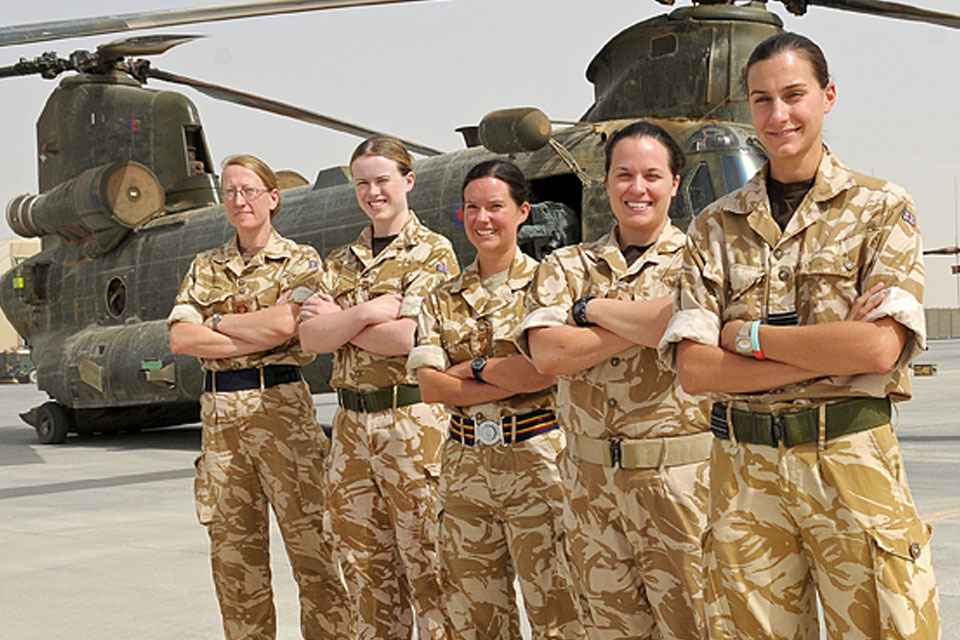All-woman team keeps helicopters flying in Afghanistan
The airframes of the Joint Helicopter Force (Afghanistan), or JHF(A), are currently being kept airworthy thanks to a tri-Service group of five female officers.

The female officers of the tri-Service engineering team line up at Joint Helicopter Command in Afghanistan [Picture: Sergeant Martin Downs RAF, Crown Copyright/MOD 2010]
JHF(A), based at Kandahar Airfield, operates five helicopter types and the engineering detachments for each are currently all managed by female officers who lead approximately 250 personnel.
These engineering teams are a crucial part of the support to British forces as was most recently witnessed during Operation TOR SHEZADA in the Sayedabad area of Helmand province.
JHF(A) operates Chinook helicopters from RAF Odiham, Merlins from RAF Benson and Royal Navy Sea Kings from Royal Naval Air Station Yeovilton, along with Army Lynx helicopters from 9 Regiment Army Air Corps, Dishforth Airfield, and Apaches from 3 Regiment Army Air Corps, Wattisham Airfield.
JHF(A) also has its own integral engineering, logistic and signals support personnel to ensure that aircraft availability can be maintained to mount operations 24-hours-a-day.
The officers themselves and the crews that fly them are extremely praiseworthy of the teams that keep the helicopters flying and directly supporting the front line.
The climatic conditions are especially challenging and Flight Lieutenant Laura Morfee, a Junior Engineering Officer on the 1310 Flight Chinook detachment, said:
The team move heaven and earth to maintain the serviceability of the Chinooks in extremely excessive temperatures; however, they know their work is directly supporting the troops on the ground.
The Chinook and Merlin aircraft are also used in the Medical Emergency Response Team role which sees a mobile airborne operating theatre deploying to collect coalition casualties.
Flight Lieutenant Katie Muldoon, a Junior Engineering Officer on 78 Squadron, said that:
… team spirit and morale is high throughout the entire JHF detachment as such missions are saving the lives of British and coalition troops.
Despite this, there is still a fair degree of banter and rivalry between the different Services. Unsurprisingly they all think their own Service and helicopter type are the best.
The various fleets have been subject to various upgrades for service in Afghanistan.

The female officers of the tri-Service engineering team - from right to left: Flight Lieutenant Laura Morfee, Captain Charlotte Joyce, Captain Kate Redfern, Flight Lieutenant Katie Muldoon and Lieutenant Nicki Wallace [Picture: Sergeant Martin Downs RAF, Crown Copyright/MOD 2010]
Captain Kate Redfern of 9 Regiment Army Air Corps has relished the challenge of bringing the new Lynx into operational service; a move she has described as ‘immensely challenging but hugely rewarding as it has brought significant extra capability’.
The diversity of the helicopter fleet is evident, as Lieutenant Nicki Wallace, the Officer Commanding of the combined engineering detachment of 845 and 846 Royal Naval Air Squadrons, prefers the hands-on traditional engineering of the venerable Sea King, while Captain Charlotte Joyce, of 4 Regiment Army Air Corps, is more at home in the digital environment of the Apache attack helicopter.
Whichever airframe they work on, the primary purpose of all the women and the JHF(A) is to facilitate tactical mobility, reconnaissance and overwatch support to the UK Task Force in Helmand and to the multinational force of Regional Command (South West).
The unit provides immediate response teams, armed escorts, and situational awareness and fire support to troops engaged in combat with the enemy on the ground.